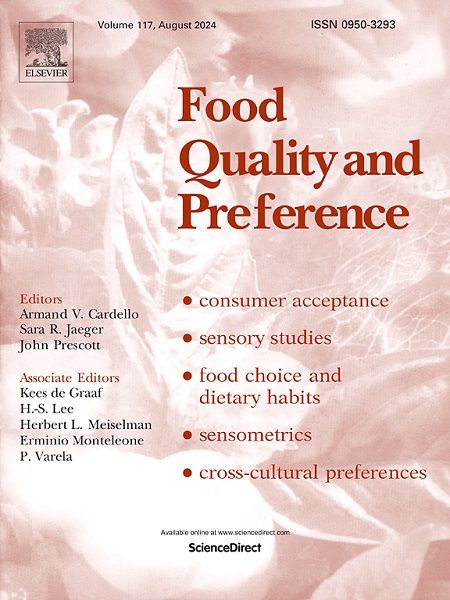嗅觉调节着不同种类巧克力的味道
IF 4.9
1区 农林科学
Q1 FOOD SCIENCE & TECHNOLOGY
引用次数: 0
摘要
苦味被认为是一种令人不愉快的味道,同时也是巧克力等受欢迎食物的主要味道。在可可饮料中加入黑巧克力的香味会通过跨模态相互作用增强苦味。食物中天然含有影响口感的挥发物,因此本文研究了内源性香气对巧克力苦味的影响。具体来说,我们在两个实验中探索了嗅觉、烘焙和可可含量的影响,让普通巧克力消费者对巧克力的苦味、甜度、酸味、涩味、可可味和坚韧不拔的程度进行了总体评分。九种不同烘焙的100%巧克力(实验1)和三种可可含量不同的商业巧克力(0 - 100%;实验2)在有和没有嗅觉输入的两组交叉设计中进行评估。在实验1中,我们发现烘焙条件与所有属性的嗅觉输入之间存在显著的相互作用,但对整体喜好没有影响。在较低温度下烘焙的巧克力对苦味、酸味和涩味的嗅觉增强更大。我们还发现可可含量与嗅觉输入对酸味和苦味之间存在显著的相互作用,可可含量越高,酸味和苦味的气味增强程度越高。在实验2中,100%商业巧克力对苦味的嗅觉效应比实验1中要小,这意味着香气质量也会影响巧克力对苦味和酸味的嗅觉增强。总的来说,嗅觉对巧克力的口感和口感的影响是复杂的,这取决于巧克力中的可可含量和可可的烘烤方式。本文章由计算机程序翻译,如有差异,请以英文原文为准。
Olfaction modulates taste attributes in different types of chocolate
Bitterness is considered an unpleasant taste, while also dominating the flavor of highly liked foods like chocolate. Adding dark chocolate aroma to a cocoa beverage enhances bitterness via cross-modal interactions. Foods naturally contain volatiles that can affect taste, so the influence of endogenous aromas on chocolate bitterness was investigated here. Specifically, we explored effects of olfaction, roasting and cocoa mass content in two experiments with regular chocolate consumers rating overall liking and intensities of bitterness, sweetness, sourness, astringency, cocoa flavor, and grittiness. Nine differently roasted 100 % chocolates (Experiment 1) and three commercial chocolates varying in cocoa content (0–100 %; Experiment 2) were assessed in two session crossover designs with and without olfactory input.
In Experiment 1, we found significant interactions between roasting conditions and olfactory input for all attributes, but not overall liking. Greater olfactory enhancement of bitter and sour taste and astringency were observed for chocolates roasted at lower temperatures. We also saw a significant interaction between cocoa content and olfactory input for sour and bitter tastes, with greater odor enhancement of these tastes at a higher cocoa content. In Experiment 2, the 100 % commercial chocolate showed a smaller olfactory effect on bitterness than in Experiment 1, implying that aroma quality also affects olfactory enhancement of bitterness and sourness in chocolate. Collectively, the effect of olfaction on taste and mouthfeel perception in chocolate is complex and depends on both cocoa content in the chocolate and how the cocoa has been roasted.
求助全文
通过发布文献求助,成功后即可免费获取论文全文。
去求助
来源期刊

Food Quality and Preference
工程技术-食品科技
CiteScore
10.40
自引率
15.10%
发文量
263
审稿时长
38 days
期刊介绍:
Food Quality and Preference is a journal devoted to sensory, consumer and behavioural research in food and non-food products. It publishes original research, critical reviews, and short communications in sensory and consumer science, and sensometrics. In addition, the journal publishes special invited issues on important timely topics and from relevant conferences. These are aimed at bridging the gap between research and application, bringing together authors and readers in consumer and market research, sensory science, sensometrics and sensory evaluation, nutrition and food choice, as well as food research, product development and sensory quality assurance. Submissions to Food Quality and Preference are limited to papers that include some form of human measurement; papers that are limited to physical/chemical measures or the routine application of sensory, consumer or econometric analysis will not be considered unless they specifically make a novel scientific contribution in line with the journal''s coverage as outlined below.
 求助内容:
求助内容: 应助结果提醒方式:
应助结果提醒方式:


